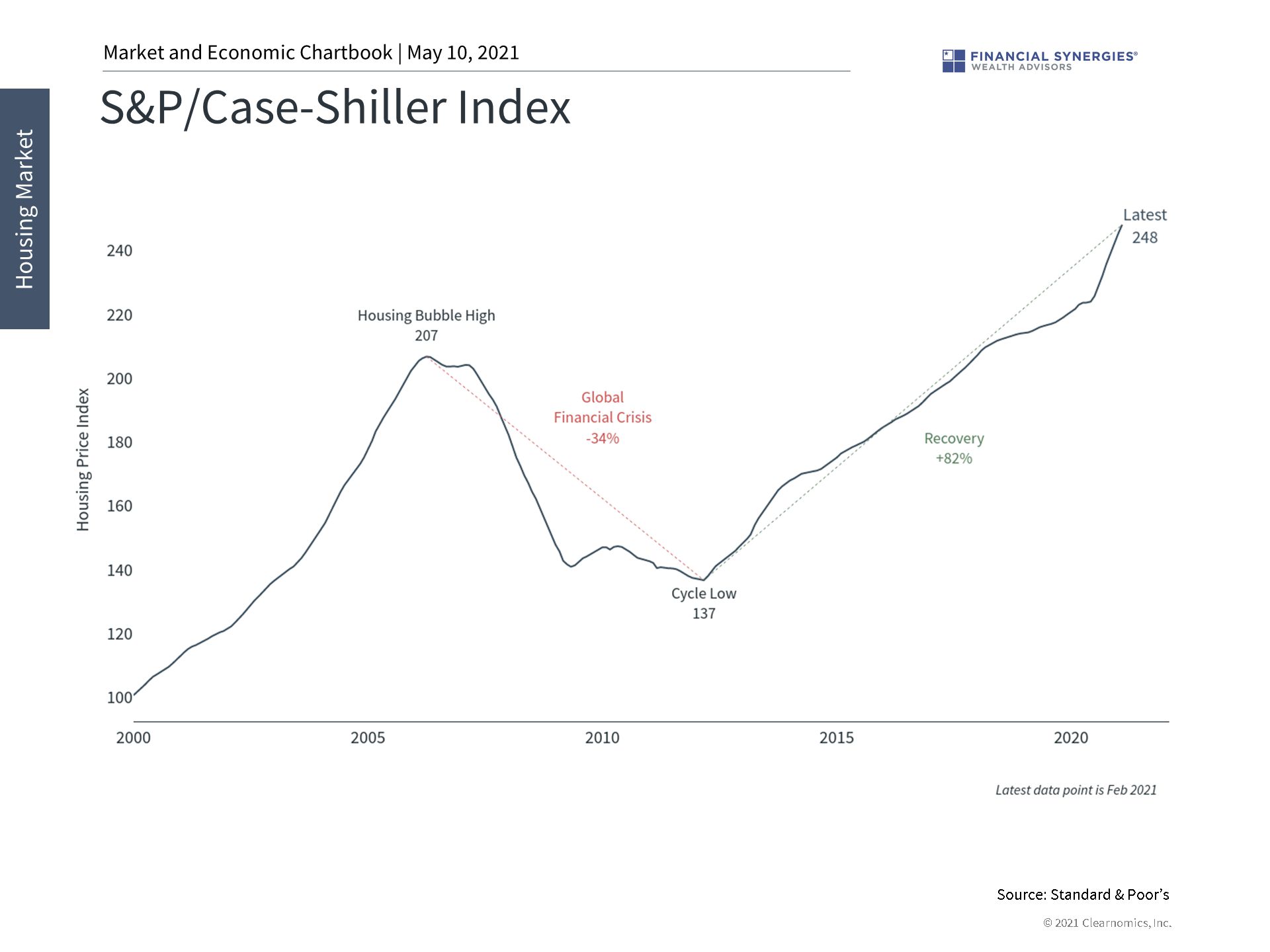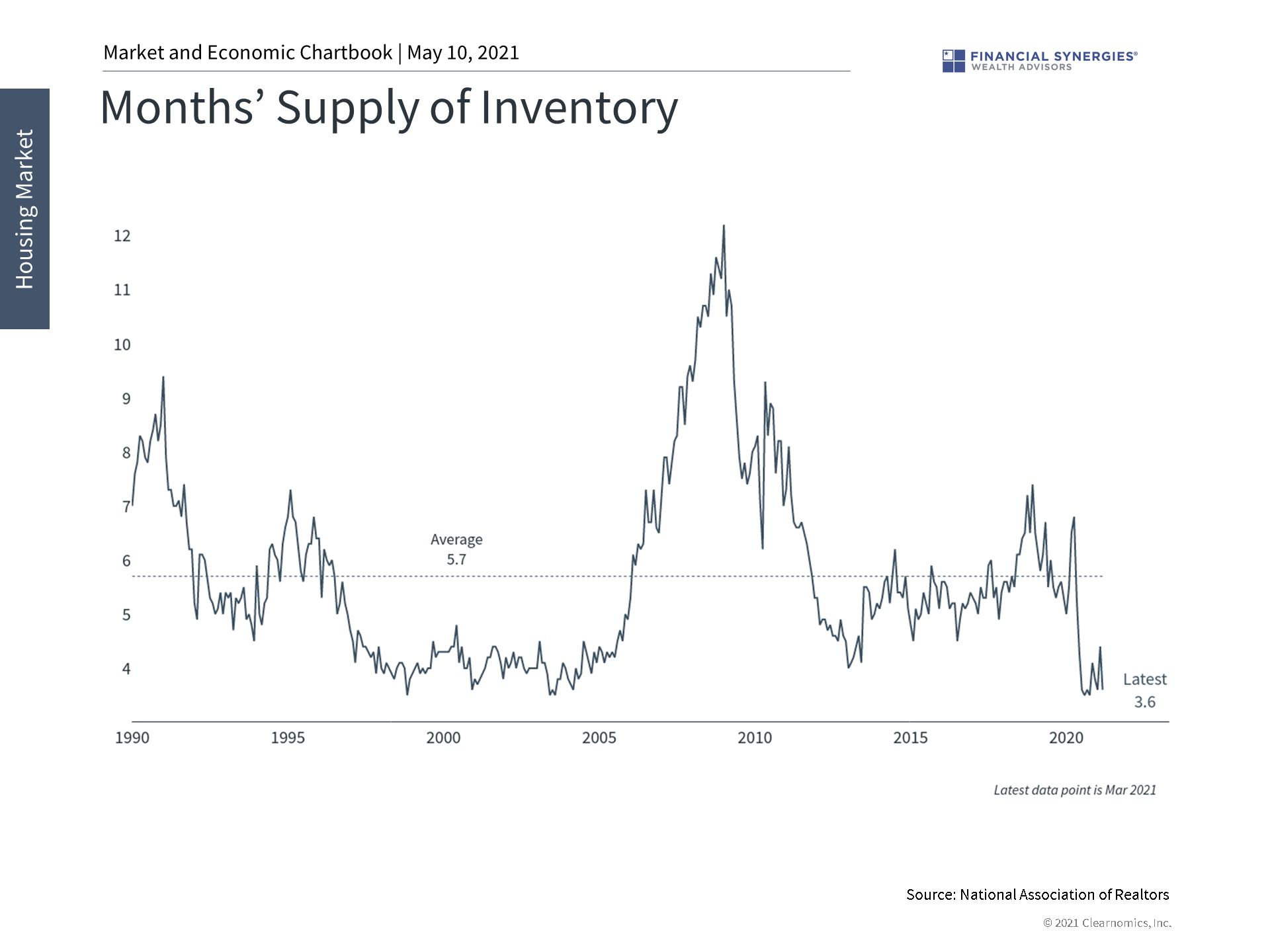One of the beneficiaries of the lockdowns and social distancing measures of the past year has no doubt been the housing market. It is well known that many flocked to the suburbs, moved to warmer climates, and traded up their homes during the early stages of the pandemic. As a result, home prices have continued to reach new all-time highs that have eclipsed the mid-2000’s housing boom. As the economy and world return to pre-pandemic levels, how does this affect everyday investors and what impact might it have on broader markets?
Naturally, housing is a basic human need and has a profound impact on our everyday lives. From an investment and economic perspective, the housing market is both itself an investable asset class as well as a macro-economic indicator of financial health. Recent data paint three important pictures from these perspectives.
First, the housing market can tell us about the economic health of consumers since homes are the largest asset for many households and mortgage payments are usually the largest expense. This creates a “wealth effect” associated with the value of one’s home – the higher and more stable that value is, the higher their perceived net worth and the more willing consumers are to spend. Although real estate is illiquid, even the perception of changing asset values may be enough to spark changes in behavior. Thus, rising housing prices have likely contributed to consumer and investor confidence – both of which have jumped in recent weeks. Combined with higher savings rates, the average consumer is likely to be in a strong position.
On the other hand, fast-rising home prices make it more challenging for new homebuyers. Fortunately, interest rates are still low by historical standards even after climbing in the first quarter. The average 30-year fixed mortgage rate is still around 3%, well below the 4% average since 2008 and 6% longer-run average. So while low rates have contributed to higher home prices, they also help to offset them and increase affordability.
Second, the housing market itself continues to face high demand and significant supply constraints, even with COVID-19 restrictions subsiding. The supply of homes available for sale, measured in terms of the number of months needed to sell, is near historic lows of 3.6 months. As a result, both building permits and housing starts have zoomed past historic averages. That this surge has been concentrated in single-family homes is consistent with the anecdotal experience of those seeking more, and better, living space.
Rising housing demand also puts pressure on other parts of the market. Lumber prices, for instance, are at historic records, rising more than 5x from the April 2020 low. Other materials including granite, bricks, concrete blocks, paint and more have all increased. Your next home remodel project could be quite expensive! While there are micro-economic factors in each of these markets, some economists expect it could take years for some of these prices to normalize.
Finally, rising home prices have contributed to the real estate sector of the stock market gaining 16% this year after declining in 2020. While only a portion of this index is related to residential real estate, the re-opening of the economy has pushed many parts of the sector higher. Continued supply/demand pressures, low interest rates, the economic recovery and other factors could continue to move in the favor of some of these industries.
As always, this is a key reason investors should stay diversified and consider a wide variety of sectors and asset classes. The housing market has been a positive sign for the macro economy, individual homeowners, and the broader stock market. Below are three charts that highlight recent data around this important sector.
1. Home prices are climbing to new historic highs

The S&P/Case-Shiller index of housing prices has climbed to new peaks – both nationwide and across the top 20 cities. This began to occur soon after the COVID-19 lockdowns as many sought more personal living space. Since then, the trend has only accelerated alongside the economic recovery.
2. The inventory of homes is near historic lows

All-time record home prices are due to limited supply and increased demand. At the moment, the months’ supply of homes is only 3.6 months – near historic lows. This has led to a surge in building permits and housing starts across the country.
3. The prices of lumber and other commodities have surged

New homebuilding activity has also resulted in historic records for the prices of lumber and other housing materials. This has surpassed even the recoveries in other economically sensitive commodities such as oil and copper.
The housing market has been strong during this recovery which is a positive sign for the economic rebound. You have no doubt experienced this in your own neighborhood or real estate transactions!
Source: Clearnomics
How Record Housing Prices Influence the Market
One of the beneficiaries of the lockdowns and social distancing measures of the past year has no doubt been the housing market. It is well known that many flocked to the suburbs, moved to warmer climates, and traded up their homes during the early stages of the pandemic. As a result, home prices have continued to reach new all-time highs that have eclipsed the mid-2000’s housing boom. As the economy and world return to pre-pandemic levels, how does this affect everyday investors and what impact might it have on broader markets?
Naturally, housing is a basic human need and has a profound impact on our everyday lives. From an investment and economic perspective, the housing market is both itself an investable asset class as well as a macro-economic indicator of financial health. Recent data paint three important pictures from these perspectives.
First, the housing market can tell us about the economic health of consumers since homes are the largest asset for many households and mortgage payments are usually the largest expense. This creates a “wealth effect” associated with the value of one’s home – the higher and more stable that value is, the higher their perceived net worth and the more willing consumers are to spend. Although real estate is illiquid, even the perception of changing asset values may be enough to spark changes in behavior. Thus, rising housing prices have likely contributed to consumer and investor confidence – both of which have jumped in recent weeks. Combined with higher savings rates, the average consumer is likely to be in a strong position.
On the other hand, fast-rising home prices make it more challenging for new homebuyers. Fortunately, interest rates are still low by historical standards even after climbing in the first quarter. The average 30-year fixed mortgage rate is still around 3%, well below the 4% average since 2008 and 6% longer-run average. So while low rates have contributed to higher home prices, they also help to offset them and increase affordability.
Second, the housing market itself continues to face high demand and significant supply constraints, even with COVID-19 restrictions subsiding. The supply of homes available for sale, measured in terms of the number of months needed to sell, is near historic lows of 3.6 months. As a result, both building permits and housing starts have zoomed past historic averages. That this surge has been concentrated in single-family homes is consistent with the anecdotal experience of those seeking more, and better, living space.
Rising housing demand also puts pressure on other parts of the market. Lumber prices, for instance, are at historic records, rising more than 5x from the April 2020 low. Other materials including granite, bricks, concrete blocks, paint and more have all increased. Your next home remodel project could be quite expensive! While there are micro-economic factors in each of these markets, some economists expect it could take years for some of these prices to normalize.
Finally, rising home prices have contributed to the real estate sector of the stock market gaining 16% this year after declining in 2020. While only a portion of this index is related to residential real estate, the re-opening of the economy has pushed many parts of the sector higher. Continued supply/demand pressures, low interest rates, the economic recovery and other factors could continue to move in the favor of some of these industries.
As always, this is a key reason investors should stay diversified and consider a wide variety of sectors and asset classes. The housing market has been a positive sign for the macro economy, individual homeowners, and the broader stock market. Below are three charts that highlight recent data around this important sector.
1. Home prices are climbing to new historic highs
The S&P/Case-Shiller index of housing prices has climbed to new peaks – both nationwide and across the top 20 cities. This began to occur soon after the COVID-19 lockdowns as many sought more personal living space. Since then, the trend has only accelerated alongside the economic recovery.
2. The inventory of homes is near historic lows
All-time record home prices are due to limited supply and increased demand. At the moment, the months’ supply of homes is only 3.6 months – near historic lows. This has led to a surge in building permits and housing starts across the country.
3. The prices of lumber and other commodities have surged
New homebuilding activity has also resulted in historic records for the prices of lumber and other housing materials. This has surpassed even the recoveries in other economically sensitive commodities such as oil and copper.
The housing market has been strong during this recovery which is a positive sign for the economic rebound. You have no doubt experienced this in your own neighborhood or real estate transactions!
Source: Clearnomics
Recent Posts
2nd Quarter 2025 Market and Economic Review
The Market Reaches All-Time Highs
Last Week on Wall Street: Broad-Based Market Rally [June 30-2025]
Subscribe to Our Blog
Shareholder | Chief Investment Officer